One of the ultimate goals of any prepper is to find preps that integrate seamlessly into daily life. It’s one thing to buy a product, put it on a shelf, and wait until a major emergency. But the real magic is when you get value in daily life and an emergency without missing a beat — you spend money on what you wanted for normal life anyway and get the prep/insurance for free!
A countertop water filter is one of the best examples of that two-birds-one-stone overlap, and the $280 Big Berkey is the incumbent king of that market. The punchline from this review is: yep, if you want a countertop filter, then you can’t go wrong buying a Berkey.
Review: Best water filters for your home
Many experienced preppers already know about this because it’s such a popular concept, but it’s worth repeating for all the new people in the community because countertop filters are such a graceful and impactful way to become more prepared.
Value in normal life:
- You get very clean and tasty water, on-demand, in your home
- It’s stylish and doesn’t at all stick out as weird or “preppery”
- Countertop filters last much longer than the more common pitcher filters
- You don’t have to install or modify anything since a countertop filter is unattached
- You don’t have to wait for slow drips, since the water is filtered over time and then sits there waiting for you
- You’re not wasting money on earth-destroying disposable water bottles or giving money to corporations that steal water from indigenous peoples
Value in an emergency: Imagine you’re sheltering at home but the water grid isn’t working or it’s tainted, such as when a local government issues a boil water notice. So you need to find wild water and then treat it.
The problem with plumbed-in systems (eg. reverse osmosis) is that you don’t have an input to feed in the wild water — if you had a bucket of river water, how would you put it through the system? Pitchers can take wild water, but they’re smaller and thus harder to keep a whole family going when it’s your only source.
Testing notes
Thank you to the folks at BigBerkeyWaterFilters.com for sending us a review sample one year ago when the entire supply chain was a mess.
A problem in this market is that all Berkeys are sold via third-party resellers, not by the manufacturer New Millennium Concepts. There’s a few scammy middlemen out there with lazy websites just trying to make a buck, but BBWF.com is one of the legit sellers.
We were going to do a head-to-head stress test between the Berkey and other top countertop gravity filters, but we couldn’t get all of the other products due to Covid inventory problems.
So instead we’ve been using the Big Berkey as our primary water source, every day for the last full year, in order to get a feel for what it’s like in daily life and where there might be little frustrations. So this is more of a lifestyle review than a technical one.
Once we get more competitors on hand, we’ll update the main comparison article with head-to-head testing, such as beating up the stainless steel body on these units to see if they can survive a fall.
Berkey basics
The design is simple: Two stainless steel containers stack on top of each other. The top one is for dirty water, where you lift a simple lid and pour. The bottom container has a spigot and holds the clean water. Filters sit at the connection between the two containers. Gravity does the work of pulling the dirty water from the top, through the filters, and into the bottom.
More: You can even hack a similar system together with 5-gallon buckets
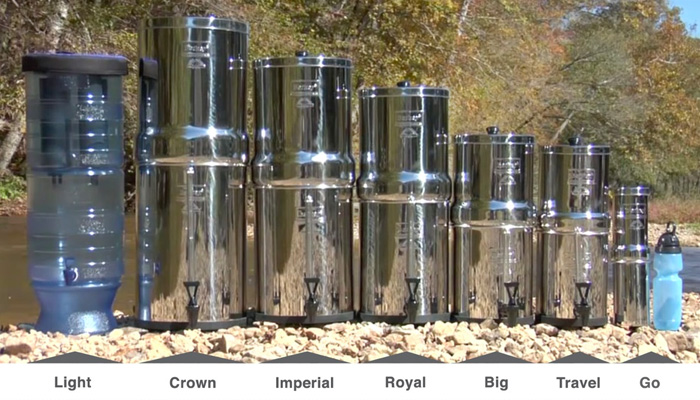
The impressive Black filters ($120 per pair) are cleanable and replaceable. We love that they print all of the threats the filter screens out right on the box. Here’s a deeper list of everything it protects against.
There are slots/holes for up to four installed at once, but it will work with only one. We’ve been running with two Black filters (with no extra fluoride etc. filters), and in a household of two people that drink a lot of water, the filters have only needed a cleaning once in the last year — and we suspect they will last at least another year. Combined with a few replacement filters in our emergency supplies, that means with just a handful of filters we can treat enough water to last for years!
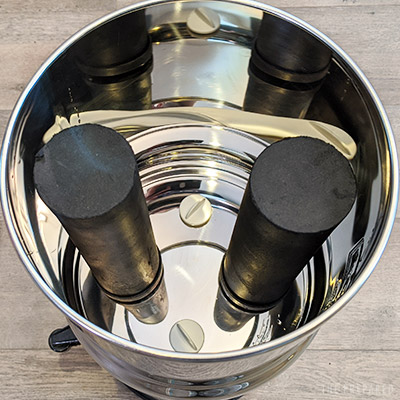
Cleaning the body and filters is pretty easy, too. The stainless body does pick up some fingerprints, but it’s not as bad as you’d think and is easy to wipe down. The filters only take a few minutes to remove, scrub with a pad, and then reinstall.
Flow rates are fine and the drip does start instantly, although this isn’t designed to filter in real time as you sit there waiting. The very first time we filled up the top container, it took three hours to fully process — much longer than the 20 minutes advertised in the lackluster instructions.
But once the filters were primed, it took about two hours to process a full upper container.
Note that Berkey filters don’t work with water that’s already gone through a water softener.
Aftermarket stands are a must-have
You can theoretically plop the Berkey right on a counter, as long as it’s sitting on an edge (eg. the sink edge) so that you have vertical space to put your cup underneath the spigot.
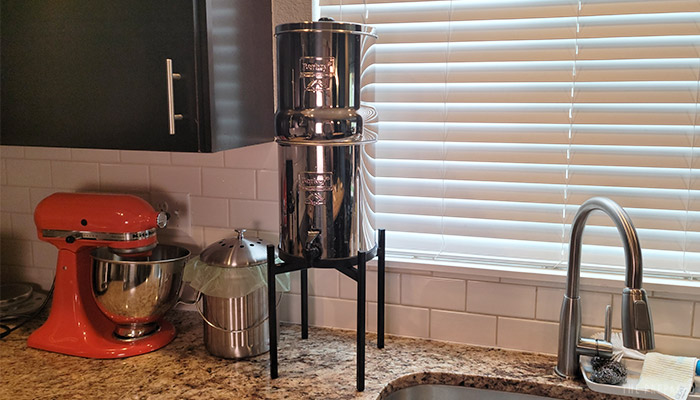
We did that for about two days before getting frustrated enough to change. So we bought this $35 third-party 10″ stand from Amazon and it made a huge difference. There’s also an official $40 wire stand. We can place the Berkey wherever we want and still have plenty of room for filling almost any glass/container.
Elevating the tank also frees up valuable kitchen counter space and, in our opinion, improves the overall look and feel of the area.
The Berkey and its official accessories are more expensive than they should be
Because we test a lot of products at The Prepared, we have a decent feel for when a product “makes sense” for the price they charge versus if the profit margin is too high.
In this case, everyone on our team who’s used a Berkey believes it’s a little overpriced — for a standard Big Berkey + two Black filters setup, you’re probably spending $50-75 more than we’d ideally like to see.
Review: Make a cheaper “DIY Berkey” with parts from St. Paul Mercantile
It’s likely the main reason is due to the Berkey being the market king for so long without much competition. But other companies are investing in competing, especially after the Covid bump, and we hope that more competition will help. If I had to guess, I’d think the price point stays the same over time but the underlying materials and features get better, rather than the vice versa.
Plastic materials are my main gripe. Too many critical pieces are plastic, and a cheap-feeling plastic at that. You can buy a $25 replacement stainless steel spigot. But we think New Millennium Concepts should just include that by default.
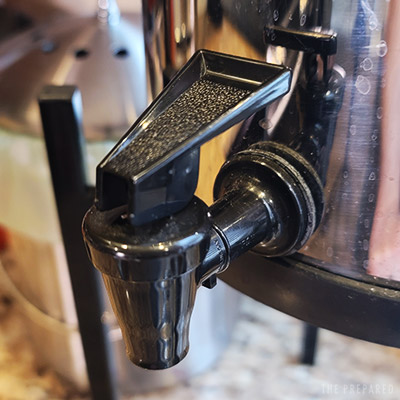
All of the other accessories are skippable, although some people want to add the extra $65 fluoride and arsenic filter. If you’re really prepping for the long term, you might want to pick up a $25 spare parts kit. The $25 Primer pump is useful when there’s no water pressure from the grid, but you can probably make do without it in this rare event.
The Sight Glass Spigot is helpful but not worth it
Clean water sits in the bottom half of the Berkey (since gravity pulls it down from the top half). From the outside, there isn’t a way to tell how much clean water is ready to use — you have to physically lift the top half and look down into the bottom half to see the water level.
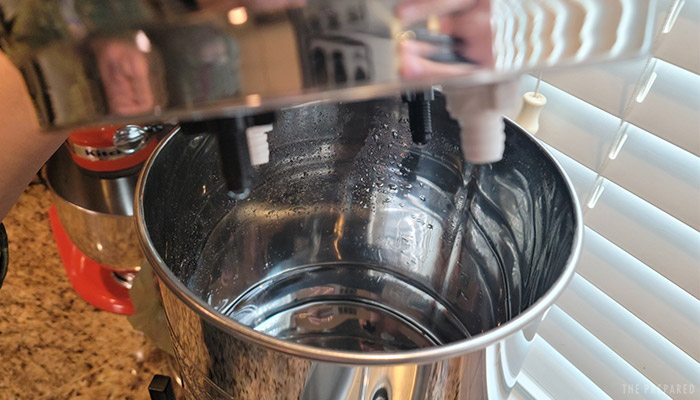
The $55 Sight Glass Spigot solves that problem. But we don’t think it’s worth it for most people because you:
- Can’t use the sight glass and the stainless steel spigot at the same time, and we’d much rather have the steel components than to solve this very mild problem.
- Can’t use the sight glass if you’re also using the add-on fluoride filters.
- Get a feel for when the bottom tank is running low because the output flow from the spigot gets slightly weaker — not enough to be a problem, but enough to notice.
- Might break it, since the sight glass hangs outside the rest of the body.
The exception would be if you’re elderly or disabled in such a way that lifting a few pounds from low-shoulder level to high-shoulder level is a problem.
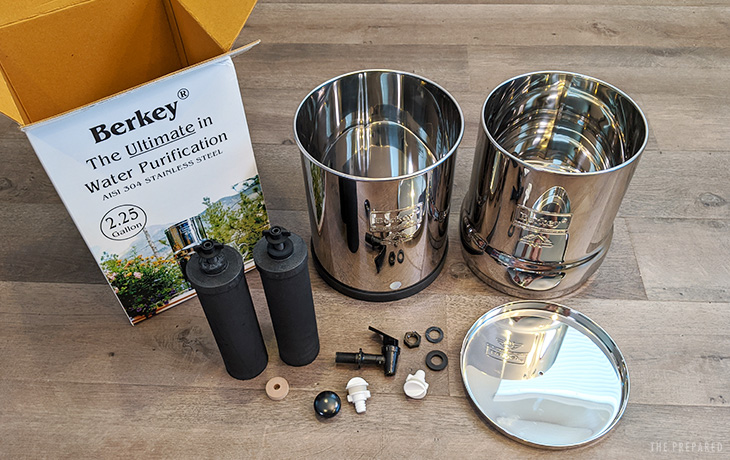
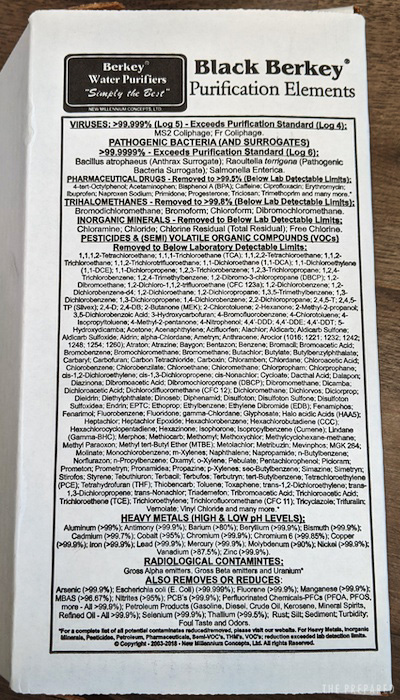
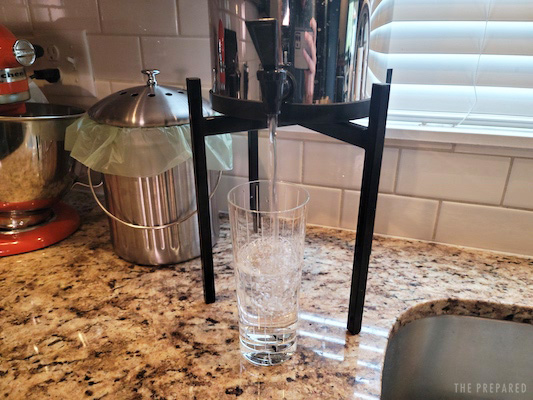
You are reporting the comment """ by on